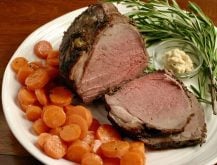In a few days we will leave for a couple of months in Arizona. While away, I will miss my turns at writing this column. When we do return in April, the weather should be warmer than today’s Ð30 C.
How often in our lives does one thing lead to another? Start fixing one part of the house and it leads to the next room and eventually the whole house. This happened when a friend asked if I knew what Stilton cheese was.
After finding information about the cheese, she said she asked because it was called for in a meat loaf recipe she had. This led me to get the recipe as it sounded like something I would like to try. We tried it and liked it and so it is in this column for others to try.
Read Also

Intergenerational rollover rules can help succession plans
One of the most significant concerns in succession planning for farmers is the tax bill that can come with passing the farm to the next generation.
Stilton cheese is a blue-veined, mould-ripened cheese that was first made around 1720 and sold in Stilton, Huntingshire, England. It owes its name and reputation to the village, but it is not made there any more.
If the flavour of Stilton is not your thing, any strong cheese such as gorgonzola, sharp cheddar, parmesan or romano will work well. I made it with some Danish blue cheese left from Christmas.
Stilton and roasted garlic meat loaf
2 pounds ground beef 1 kg
1/3 pound Stilton cheese, 170 g
crumbled
1 tablespoon roasted 15 mL
garlic, pureed
1/4 cup bread crumbs 50 mL
1/2 teaspoon salt 2 mL
1 teaspoon pepper 5 mL
Mix all together in a bowl. Put in a loaf pan and bake in a 350 F (180 C) oven for 50-60 minutes.
To roast garlic: cut 1/4 inch (0.5 cm) off the whole head so the cloves are just showing. Drizzle a little canola or olive oil over the garlic. Wrap loosely in foil and bake in a preheated 350 F (180 C) oven for 45 minutes or until soft. Squeeze softened garlic out of skins and puree. Roasted garlic puree may be frozen for up to one month. When garlic is slowly roasted, the cloves steam inside their skins until the centres become creamy soft and sweet. Roasted garlic can be served in a variety of recipes, for example by squeezing onto toasted French bread slices, in mashed potatoes, on meat or in marinades and soups.
Cream of mushroom soup
2 tablespoons butter, 30 mL
margarine or oil
1 small onion, finely chopped
1/2-3/4 pound mushrooms, 250-375 g
chopped
1/4 cup flour 50 mL
1/2 teaspoon salt 2 mL
31/2 cups milk 875 mL
1 tablespoon powdered 15 mL
chicken bouillon or a
cube, dissolved in 1/2 cup
(125 mL) water
pinch of thyme
salt and pepper, to taste
Sauté mushrooms and onion in butter. Add flour and stir to coat. Add milk and bouillon and stir until thickened and smooth. If too thick, thin with a little water or more milk.
Add seasonings and simmer for 10-15 minutes on low heat. Serve with a sprinkle of parsley. Serves four or five.
Plastic in the microwave; flax question
Dear TEAM: My reason for writing is for information on using plastic containers, such as those that sour cream come in, in the microwave. This is a common practice for cooking puddings, etc., in some restaurants. I read once where this type of plastic gives off toxins that are harmful.
Also, is golden flax more healthy than regular brown flax? Price wise the golden flax is more healthy for the seller’s bank account – $40 for the same amount I paid $4 for in the brown variety direct from the grower. – E.S., Morinville, Alta.
Dear E. S.: Is it safe to put plastic wrap and plastic bowls in the microwave?
According to research from the School of Public Health at University of California, Berkeley, March 2002, the answer is no one knows if these compounds are a danger. Since plastic has not been around for long, the risk of chemicals found in plastic to human health remains uncertain.
You can avoid problems by taking the following precautions. It is better to err on the side of caution.
- Buy wraps that are approved for use with microwaves because most of these will not contain plasticizers. Look for wraps that have manufacturer’s instructions for using in a microwave; they will be approved.
- Whatever brand you use, be sure the wrap does not touch food while it is heating in the microwave. “Tent” it loosely over the food. Don’t seal the edge: leave room for steam to vent. If your wrap does contain plasticizers, they can leach out, but only if they touch the food, and only in small quantities. This has not been shown to be a health risk, but it makes sense to avoid it just in case. Another concern is the wrap could melt and ruin the food.
- You can use waxed or parchment paper, or regular paper towels instead of plastic wrap.
- Before defrosting meat in the microwave, remove the plastic wrap.
- Use only plastic containers labelled microwave-safe. This means the plastic is inert, so no chemicals will migrate. They will also be strong enough to withstand heat. Margarine containers, whipped topping tubs and other thin plastic bowls may warp, and you might get burned when you touch them – a more immediate problem than migrating chemicals.
- Restaurant take-out containers and food carriers usually are not intended for the microwave, so transfer your food into a microwaveable container.
- Don’t reuse those compartmented trays that frozen dinners often come in. They are meant to be discarded after one use, as the packages say.
- Don’t use thin plastic storage bags, brown paper or plastic grocery bags or newspaper.
- Avoid microwaving food in freezer cartons and on Styrofoam trays.
Gold flax or brown?
The Flax Council of Canada has your flax health question listed as one of the most frequently asked questions it receives. One flaxseed is not better for you than another. Brown flaxseeds provide the same nutritional benefits as golden. Both brown and golden flaxseeds have plenty of lignans and dietary fibre, and both contain more than 50 percent alpha-linolenic acid. This is an omega-3 fat that helps maintain heart fitness.
Brown flaxseed may be more commonly found than golden, as more brown is grown commercially.
There is another yellow seed that looks like flax, but is not flax. It is most likely solin seed, a crop developed from flax. Solin seeds do not provide the same nutritional benefit as flax. Solin seeds contain less than one-tenth of the alpha-linolenic acid found in flaxseed.
Recipe request
Dear TEAM: I am looking for a square that has graham wafers layered with a mixture containing cream of wheat and cream cheese. – J. K., Edenwold, Sask.
Would anyone have this recipe? I was unable to find it.
Maple bugs
Dear TEAM: Last year and the year before my garden was simply overrun with so-called maple bugs. They ruin the rhubarb, are all around the fruit trees and all over the garden. I would like to know if there is any way of getting rid of these pests without spoiling my garden site. – M.P., Balcarres, Sask.
Dear M.P.: The box-elder bug (Leptocoris trivittatus) is commonly called the maple bug.
In the spring 2002 issue of The Gardener magazine, there is an article about this bug written by Patricia Richardson, a horticulturist at the University of Saskatchewan extension division.
She said adults and nymphs are sap suckers, feeding on seeds, foliage and tender twigs. The feeding punctures cause dimples and deformities on the seed pods and some distortion of the leaves. Apparently damage is usually minimal and does not warrant chemical intervention.
The Garden Line at the University of Saskatchewan also does not recommend any chemical control as the damage done by the bugs is minimal compared to the environmental impact of the chemical.
When box elder bugs find their way indoors, they will not eat anything in the home and are considered just a nuisance pest. They may stain walls and furnishings with fecal material.
You could contact the Garden Line when it opens this spring by calling 306-966-5567 or e-mail gardenline@usask.ca. For subscriptions to The Gardener magazine, phone 306-966-5593 or write to: The Gardener, P.O. Box 378, RPO University, Saskatoon, Sask. S7N 4J8.
Alma Copeland is a home economist from Rosetown, Sask., and one of four columnists comprising Team Resources. Send correspondence in care of this newspaper, Box 2500, Saskatoon, Sask., S7K 2C4, or send e-mails to team@producer.com.














